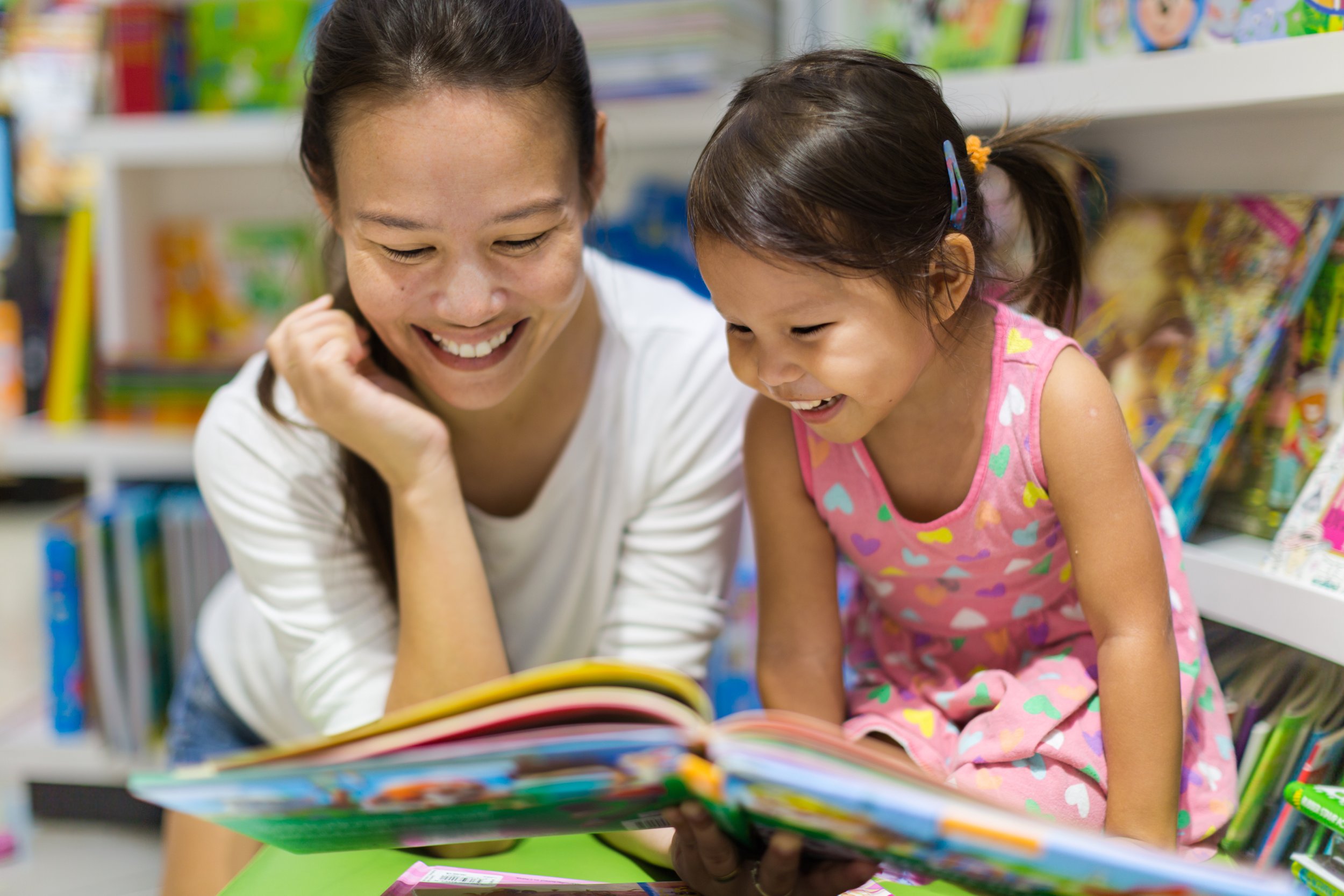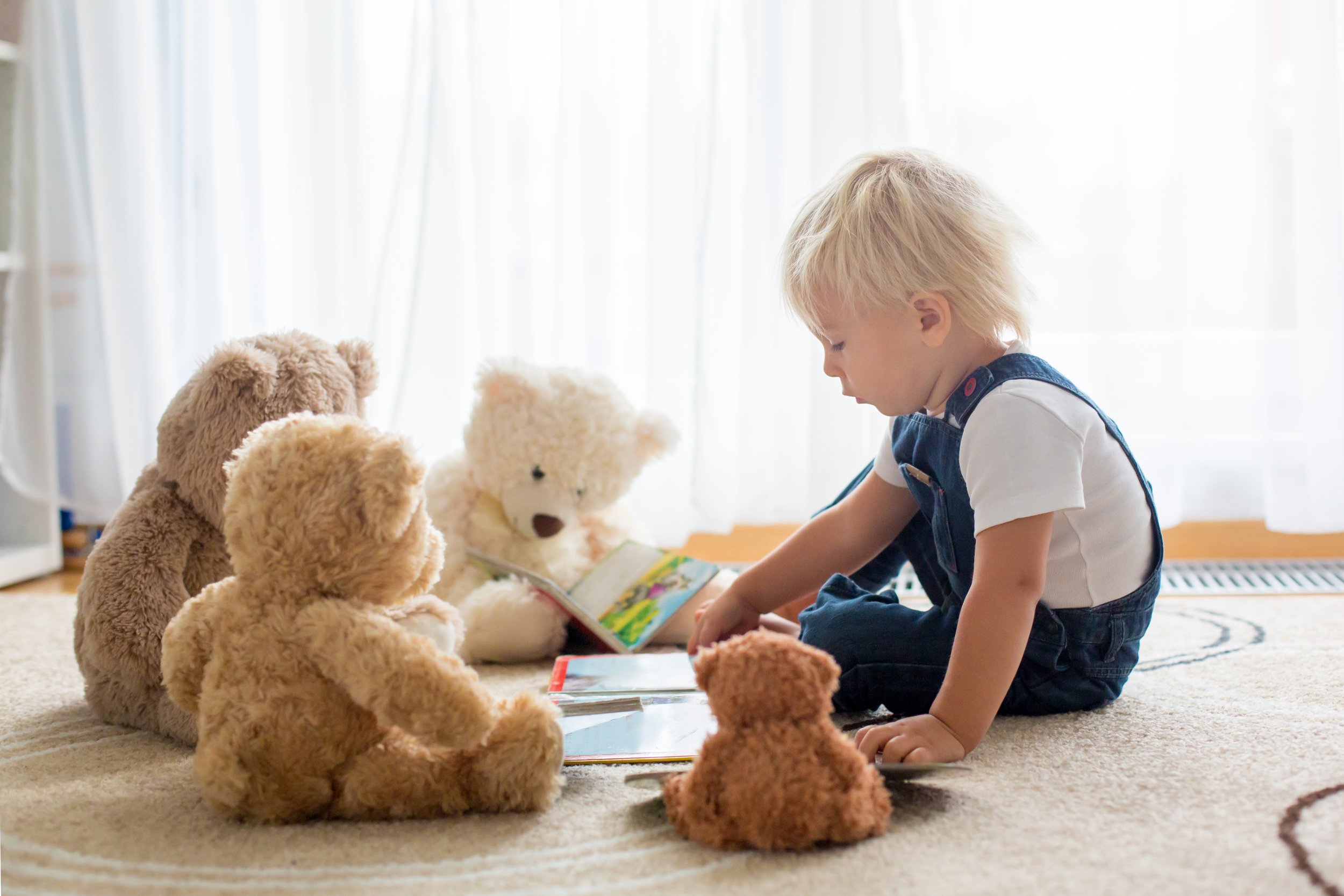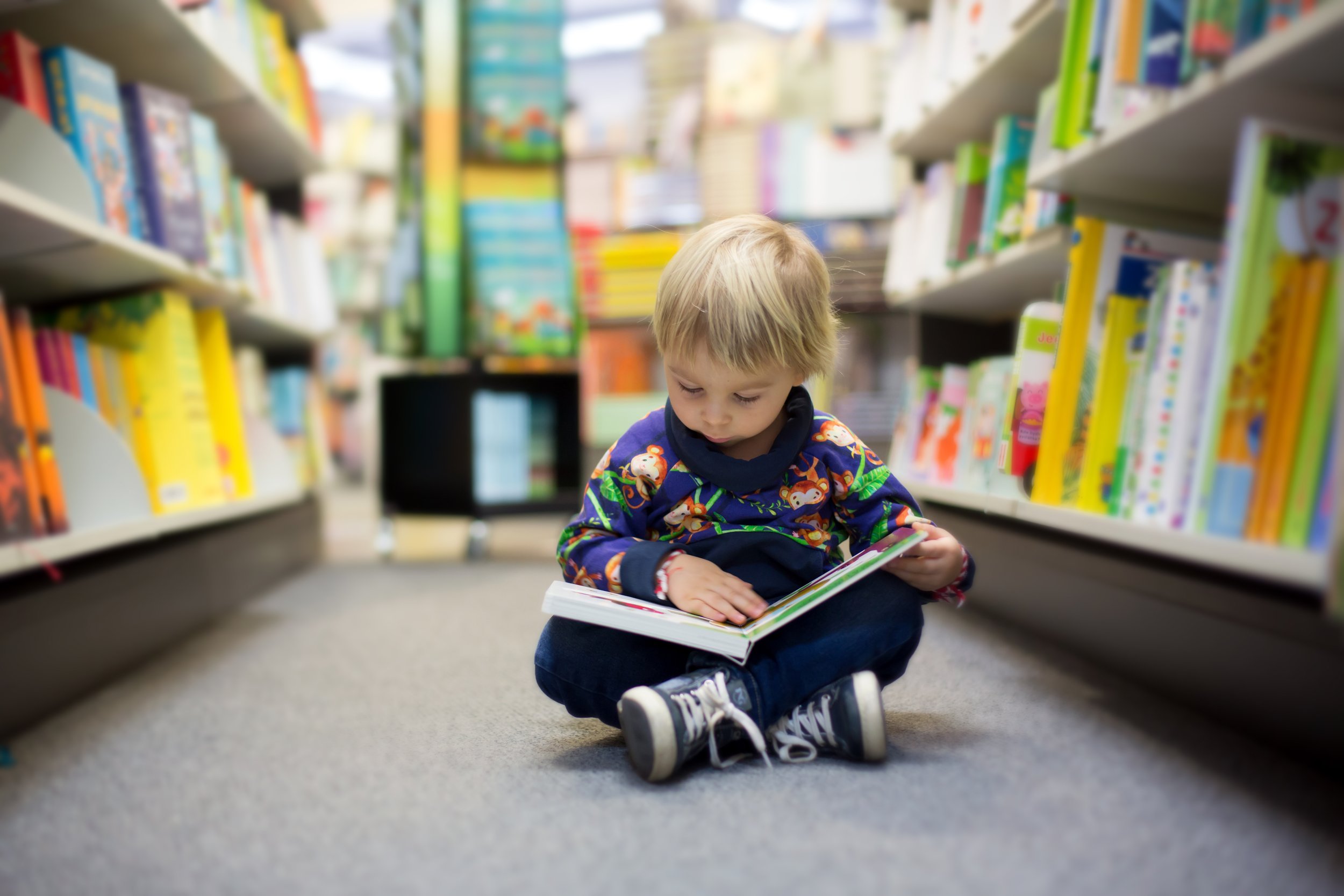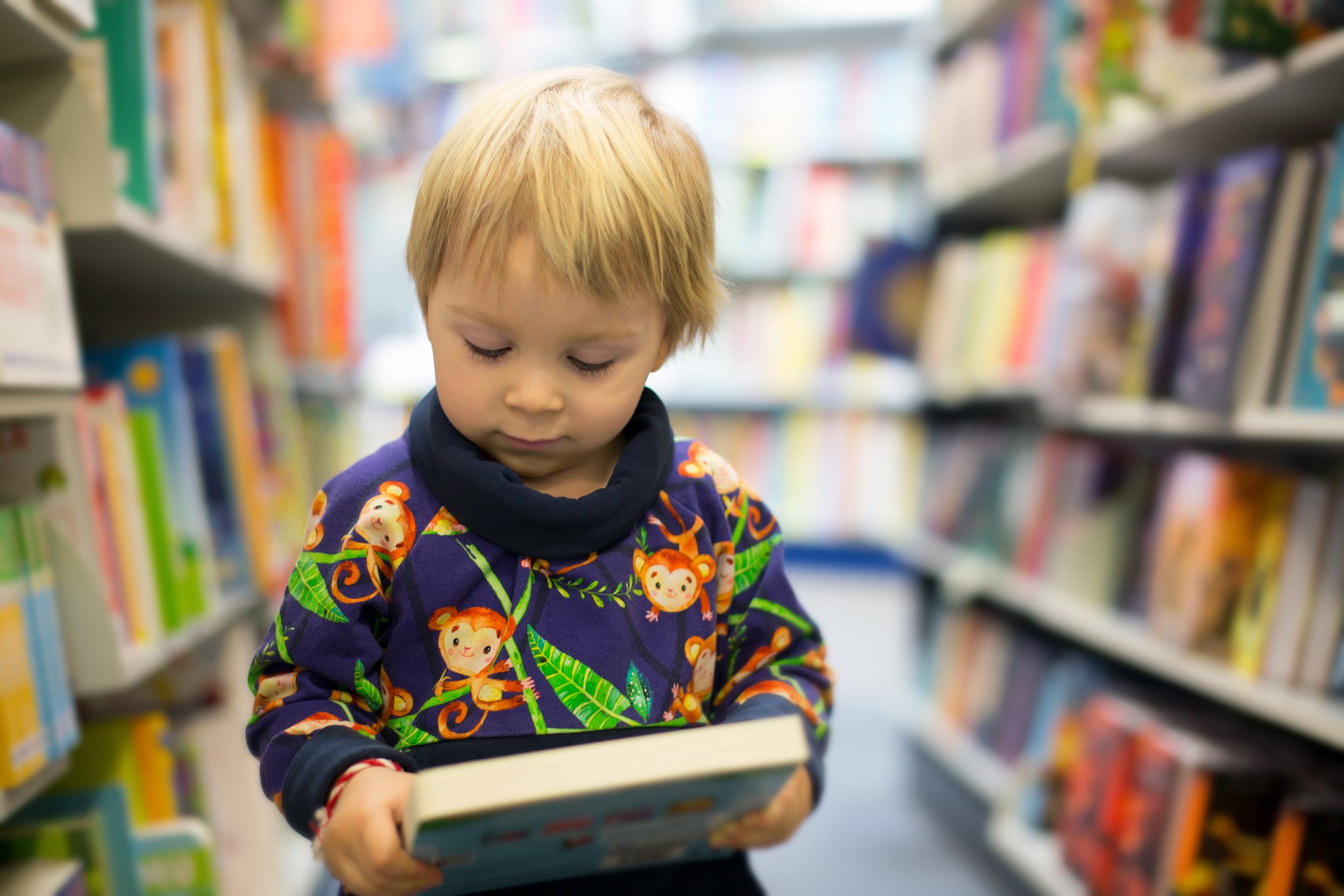How to pick the best toddler books!
Reading books can help toddlers learn new words and communication skills IF reading books is enjoyable for them. That’s because toddler’s need to be engaged in order to learn new things.
You might be thinking, “That’s great, but my toddler hates books!”
This post is all about how to choose the best books for your toddler and how to turn reading time into a fun and fruitful experience. We’ll talk about:
Why toddler books?
Books are compact, inexpensive, colorful ways for your child to be exposed to new vocabulary and new concepts. Books can be borrowed for free from your library, including durable cardboard books. Best of all, book sharing is a fun interactive way for you and your child to spend some time together. With any luck, you can help your toddler learn to love books at an early age.
How to choose the best books for toddlers?
There are lots of different books out there. For the strategies we describe to work it’s important that you find, purchase, or borrow a book/magazine that:
Has pages. Yes, there are interactive books on tablets and books that can be watched on TV. For this activity, we want your child to have the ability to turn the pages, look at the book on their own, and have the opportunity to create their own sound effects/ words without the assistance of technology.
Has pictures that are interesting to look at, especially if there is action in the pictures. Books that just have a picture of a ball on one page, an apple on another are harder to talk about because there is nothing going on. Look for a book where people or characters are doing something exciting!
Is interesting to your child.
Your book DOES NOT have to have words or even be in your language. This is because you can make up your own words!
The goal of toddler books
No matter what your child’s communication level is, your goal for book time is simple: help your child learn to love books. Notice the goal is not “learn to read”, “learn your colors,” “learn to count,” or “learn your letters.” There is plenty of time for children to use books later in life to learn academic skills.
If you are book sharing with a baby, toddler, or preschooler, your focus is different than with a school-age child. You want your child to walk away from the time together having enjoyed themselves, enjoyed spending time with you, and looking forward to the next time that they get to look at a book with you or by themselves. To accomplish this, you are going to be fun, playful, and interactive with your child while you look at a book together.
In this section, we call it “book sharing” instead of “book reading.” To have a great time sharing a book with a child, we are going to tell you a little secret: you don’t always have to read the words in the book. In fact, for some books, this is a guaranteed way to have your child get up and leave.
Some books and authors do a wonderful job providing you with a good balance of text and pictures to keep your child interested and excited. But sometimes the story is too abstract, the words are too hard, or there is simply too much text on the page for the age/ developmental level of the child who is listening to it. You can always ignore the text and tell the story your way. You can also just talk about the pictures without telling the story.
Remember, your goal is to help your child learn to love books. If your child’s interest level is such that listening to a story beginning to end is too boring, that is okay. Perhaps book sharing with your child might include simply going through all the pages and looking for the red cars, pretending to pet the dogs on the pages, or pretending to eat the food in the illustrations. Perhaps you start in the middle and just look at your favorite pages. There’s no right or wrong way to enjoy book sharing with your child!
Explorers: Toddlers who communicate with gestures
Pioneers: Toddlers who say 1-100 words
Builders: Toddlers who talk in short sentences
For the purpose of this text, we are going to talk about The Very Hungry Caterpillar by Eric Carle.
But, we also included a list of other favorite books for toddlers at the end of this post :)
Explorers
How to “Read”:
When you share the Very Hungry Caterpillar with your Explorer, try to get your child to look at pictures on the page for a few seconds.
You can either sit with your child on your lap or you can be face to face with the book facing your child on the floor. If your child reaches for the book and tries to turn the pages, that is okay, let them explore! Open the book. Point to things on the pages and say simple sentences about them. If your child reaches for something on the pages, say what it is that they are looking at. Don’t worry about spending too long on each page. With an Explorer, it is possible that a page may only hold their interest for a few seconds. You can point to something, label it, and then turn the page.
The Very Hungry Caterpillar has holes in the pages. You can stick your finger in the holes and say “wiggle wiggle!” Encourage your child to copy you.
You can tap the pages of the book with your fingers and say “tap tap tap!.” You can encourage your child to try to copy tapping the book.
What to Say:
Don’t ask any questions when you book share with your Explorer. Instead, point and label things in the book using single words or short sentences. If it is interesting to your child, you can read the words. But it is possible you will simply talk about the pictures instead.
“The egg is on the leaf. Leaf.” [as you point to the egg and the leaf]
“Pop!”
“Ooh, a strawberry! Strawberry!” [as you point to each strawberry when you label them.]
Pioneers and Builders
When you share The Very Hungry Caterpillar with your Pioneer/Builder, you will help your child remain engaged with the book by talking about the pictures and giving a short, animated version of the story. Keep in mind throughout that your goal is for you and your child to have fun together with a book. You might have to keep adjusting what you are doing/ saying to keep your child interested.
How to “Read”:
You can either sit with your child on your lap or you can be face to face with the book facing your child on the floor. If your child reaches for or talks about something on the pages, even if it is not what you were talking about, that is okay. Talk about the thing that your child is interested in.
Don’t worry about spending too long on each page. With a Pioneer/Builder, it is possible that a page may not hold their interest long enough for you to read all the words. That’s totally fine. You can make up a shorter version of the text. Or instead of talking about the story, you can just point to the most interesting thing on the page, say a sentence about it, and then let your child turn the page.
When you come to the food pages, pretend to eat the food in the pictures. Say, “I’m eating a plum!” Then pretend to pick it up off the page and eat it. Make it look fun and see if your child copies you.
You can use your finger or a puppet (yes, a regular sock on your hand counts as a puppet) to be a “caterpillar.” Pretend that your caterpillar is eating the images in the book. Your child can have a sock puppet too.
What to Say:
On each page, read the sentence (if your child is interested.) Then, say another sentence about what you see. Don’t ask your child too many questions about the book because this will turn a fun “book sharing time” into “quiz time.”
“Look, there is the egg.”
“There is the caterpillar. He is hungry.”
“Ooh, cake! I’m eating cake too.”
“Do you want some cake?”
“My caterpillar has a tummy ache. Burp!”
When book sharing with your Pioneer/Builder, make sure that you pause after you say something just in case your child wants to copy you.
This post contains affiliate links. As an Amazon Associate, Toddler Talk earns from qualifying purchases. Proceeds help support these resources.
10 favorite speech therapy books for toddlers:
You can apply the same strategies that we shared for the Hungry Caterpillar for all of these books!
Don’t forget about the library!
Books are a great way to teach your toddler about things, places, and activities that don’t happen in their day to day life. During the pandemic, books are an especially great way to grow your toddler’s vocabulary and exposure to new things.
Going to the library to check out new books is a great way to get a variety of books. Public libraries also often have story time and other community resources (like tickets to the Zoo here in San Diego!) and I would be remiss not to remind you how amazing the public libraries are in a post all about toddler books!
Parents Also Asked:
-
There are many ways to do speech therapy at home, and the best way for your child will depend upon their individual development. We have created tips and activities to help toddlers practice speech therapy activities at home in every stage of their communication development; you can find those lessons and ideas here: The Toddler Talk Program
-
Focused stimulation is one of the most common speech therapy techniques used with toddlers. Focused stimulation is the strategy of using specific words for the names of things (like car, dog, and tree) rather than general words (like it and that). Learn more about how you can easily use focused stimulation here: Focused Stimulation Lesson
Another popular toddler speech therapy technique is getting eye-level with toddlers. This is an effective technique because toddlers learn by copying what they see, and it’s easier for them to copy our sounds and words when we are face to face with them. You can learn more about this strategy here: Face to Face Lesson
-
The best book for your 2 year old is any book they enjoy. I recommend picture books that tell a story rather than the baby’s first words books because the story books have more exciting illustrations which means there are many more things you can talk about with your toddler as you look at the book together!
-
At 18 months, look for toddler books with stories about things your child is interested in, like dump trucks or animals. Finding books with illustrations that capture your toddler’s attention will ensure that book reading is fun and engaging for them.
Written By: Stephanie Burgener-Vader MA CCC-SLP
Stephanie Keffer MS CCC-SLP
© 2020-2025. Stephanie Keffer Hatleli, MS CCC-SLP. All Rights Reserved.
The content offered on ToddlerTalk.com is for informational purposes only. Toddler Talk is not engaged in rendering professional advice, whether medical or otherwise, to individual users or their children or families. No content on this site, regardless of date, should ever be used as a substitute for direct medical advice from your doctor, speech language pathologist, or other health professional. By accessing the content on ToddlerTalk.com, you acknowledge and agree that you are accepting the responsibility for your child’s health and well-being. In return for providing you with information related to home speech and language practice, you waive any claims that you or your child may have as a result of utilizing the content on ToddlerTalk.com.
















